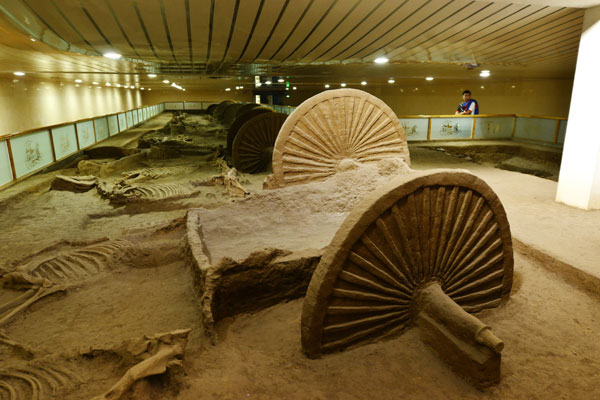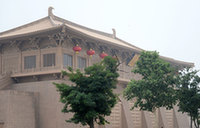 |
|
Remains of chariots and horses unearthed in a Spring and Autumn Period (770476 BC) tomb in Linzi, Shandong province. [Photo by Ju Chuanjiang/ China Daily |
Archaeologist Wang Yongbo, 61, still clearly remembers the day 25 years ago when he and his colleagues discovered a large ancient chariot and horse burial site in Linzi, Shandong province.
 |
Remains of 38 horses and 13 carts lie in a 300-square-meter tomb from the Spring and Autumn Period (770-476 BC) on a river bank. Much of the carts' wooden frames and horse bodies have rotted away, but relics of wheels, bones and bronze decorations still remain, hinting at their once-mighty presence.
"It was spectacular! We were thrilled by the find as it was the first time such a large-scale chariot and horse burial pit had been excavated in the province," recalls Wang, a researcher with the Shandong provincial institute of cultural relics and archaeology.
In ancient China, the death of a royal or nobleman was often accompanied by the sacrifice of horses and chariots, to show the master's status and to help him on the last journey into the land of the immortals, Wang explains.
The tomb had once been robbed so most burial articles were missing, and its master has not been identified. "But the scale and burial style lead us to believe the master must have been a high-ranking official or a monarch during the Spring and Autumn Period," Wang says.
The site was included in the top 10 list of archaeological discoveries in China in 1990 by the State Bureau of Cultural Relics (now the State Administration of Cultural Heritage). Today, a museum has been built at the site of the remains, just 5 meters underneath an expressway connecting the cities of Jinan and Qingdao.
With a collection of relics, ruins and other displays, the museum tells the story of chariot-making in ancient China. It is regarded as one of the first and the most complete facilities of its kind in the nation, Wang says.
|
|
|
|
|
|
|
|
